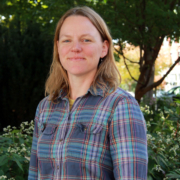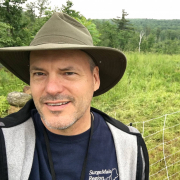By Nina Prater, NCAT Agriculture Specialist
Almost every day, I am lucky enough to be able to take a quick walk to the creek that runs at the western edge of our property. I watch it change with the seasons. It becomes a tumultuous riot in the spring, sometimes it dries out completely in a droughty summer, in the fall the river birches drop their yellow leaves that float like tiny boats down the calm current, and in the winter ice forms on the banks and on the branches that dip into the water. This stretch of creek that feels like an old friend to me is affected by everything that happens upstream – how people manage their farms, yards, forests, and even their septic systems, as well as development – and it all can impact the clarity of the water, the health of the insects, birds, fish, amphibians and even people who spend time at the water.
This was on my mind when I was researching for an ATTRA podcast I recently recorded with my NCAT colleagues, Guy Ames and Lee Rinehart. We tackled the topic of phosphorus, an element essential for life and productive farming, but one that can have devastating negative impacts on lakes and streams if it washes off the land and into the water.
Over-application of phosphorus either in the form of a synthetic fertilizer or as manure is one of the main reasons for the huge dead zone in the Gulf of Mexico and for miles of beaches being closed every summer because of toxic algae blooms in lakes, rivers, and coastlines around the country.
I personally refuse to accept that this is “the price you pay” for food security. There are so many better ways to manage the essential macronutrient of phosphorus, and to manage waste from livestock operations so it is a resource, not a waste product, while still growing the food our communities need. We can have our clean waters and eat our cake too. (Is that how that expression goes? Something like that.)
Here are some ways to make sure you are being a good steward of your land and all the waterways downstream from you:
Regular soil testing: If your phosphorus levels are already high, don’t apply more!
Manage pH: If your soil pH is above or below the ideal range of 6-7, phosphorus becomes much less plant-available. Try to adjust your soil’s pH first before adding phosphorus.
Encourage mycorrhizal fungi: Mycorrhizal fungi partners with plant roots to help the plants access more phosphorus, in exchange for photosynthates. Try to reduce tillage to avoid damaging mycorrhizal fungi and have a diversity of plant species.
Choose the right cover crops: Some cover crops are good at scavenging and holding phosphorus in organic forms.
Follow the four R’s of fertilization: Right rate, right source, right placement, and right timing.
Keep your soil protected: Prevent phosphorus from leaving your fields in the form of soil erosion.
There are many other strategies for phosphorus management. Find our recent podcast here where we talked about the history of phosphorus fertilizer, the importance of getting it right, more tips and tricks for proper management, and much more. We all deserve to live and work on farms and ranches where you can take a dip in a cool creek after a long day’s work and not worry about fish kills and toxic algae. Proper soil and phosphorus management is essential in order to keep our waterways thriving. I’m sure everyone has their favorite spot like my creek – a swimming hole, a lake, a pond, a stream, a favorite beach vacation spot – some place you have special affection for, some place that can motivate you to find the best way to grow food or fiber, without causing harm. To find out more ways to do this, listen to our podcast, or reach out to me, Guy, Lee, or one of our many other ATTRA specialists. We are more than happy to hear about your favorite fishing hole and help you find ways to be a productive farmer with a good fertility management plan.
Related ATTRA Resources:
Episode 304. Phosphorus and the Beauty of Biology
Toolkit: How to Reduce Synthetic Fertilizer Use
Rising Fertilizer Costs: Look to History for Answers
Nutrient Management Plan (590) for Organic Systems
Nutrient Management in Organic Small Grains
This blog is produced by the National Center for Appropriate Technology through the ATTRA Sustainable Agriculture program, under a cooperative agreement with USDA Rural Development. ATTRA.NCAT.ORG.

 Nina Prater has been with the National Center for Appropriate Technology (NCAT) since 2016 as a Soil Specialist and Outreach Coordinator in the Southeast Regional Office. She strives to help farmers understand soils as a living entity so that they are able to farm profitably and build healthy soils for long-term success. Nina also works closely with the Gulf States Regional Office staff to coordinate outreach efforts in that region. Nina served as an Energy Corps member in 2013 and worked for her local conservation district for 2.5 years before joining NCAT. Nina and her husband Jeremy own and operate a small sustainable livestock operation in the Ozarks hills of Arkansas, where they raise meat goats, cattle, hogs, and poultry. They utilize adaptive grazing methods to build soil health in their pastures.
Nina Prater has been with the National Center for Appropriate Technology (NCAT) since 2016 as a Soil Specialist and Outreach Coordinator in the Southeast Regional Office. She strives to help farmers understand soils as a living entity so that they are able to farm profitably and build healthy soils for long-term success. Nina also works closely with the Gulf States Regional Office staff to coordinate outreach efforts in that region. Nina served as an Energy Corps member in 2013 and worked for her local conservation district for 2.5 years before joining NCAT. Nina and her husband Jeremy own and operate a small sustainable livestock operation in the Ozarks hills of Arkansas, where they raise meat goats, cattle, hogs, and poultry. They utilize adaptive grazing methods to build soil health in their pastures. Lee Rinehart is a graduate of Texas A&M University, where he studied animal science and agricultural education. He currently works as an agriculture specialist in the National Center for Appropriate Technology’s Northeast Regional Office, where he focuses on pasture and rangeland ecology and grazing systems. He has served as county Extension agent in Texas and Montana, organic farm educator in Pennsylvania, and cattle ranch manager in central Texas. His specialty is developing grazing plans and assisting producers in using animals to renovate pastureland. Lee is a Chief Petty Officer in the Navy Reserve and spends his free time biking, sailing, and renovating his 1925 Cape Cod house in Northeast Pennsylvania.
Lee Rinehart is a graduate of Texas A&M University, where he studied animal science and agricultural education. He currently works as an agriculture specialist in the National Center for Appropriate Technology’s Northeast Regional Office, where he focuses on pasture and rangeland ecology and grazing systems. He has served as county Extension agent in Texas and Montana, organic farm educator in Pennsylvania, and cattle ranch manager in central Texas. His specialty is developing grazing plans and assisting producers in using animals to renovate pastureland. Lee is a Chief Petty Officer in the Navy Reserve and spends his free time biking, sailing, and renovating his 1925 Cape Cod house in Northeast Pennsylvania.